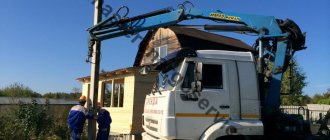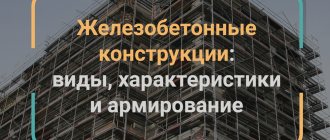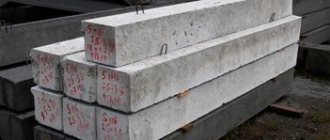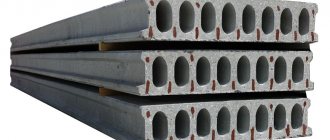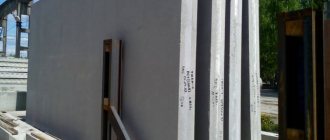A complete list of overhead line supports presented on our website can be found on the tabs below. Select first the material from which the pole is made, and then the line voltage rating. After this, go to the page with the list of overhead line supports. Please note that the list of supports is constantly updated.
Wooden overhead line supports
- VL-0.4 kV
- VL-6.10 kV
- VL-35kV
- VL-110kV
- VL-220kV
Reinforced concrete supports for overhead lines
- VL-0.4 kV
- VL-6.10 kV
- VL-35kV
- VL-110kV
- VL-220kV
- VL-330kV
Metal supports for overhead lines
- VL-6.10 kV
- VL-35kV
- VL-110kV
- VL-220kV
- VL-330kV
Power line supports are perhaps one of the most complex elements of power lines. When designing and constructing these structures, it is necessary to take into account both the climatic and soil characteristics of the area. Currently, pole manufacturers are striving to reduce the cost of production and increase the strength characteristics of products.
In view of this, various designs are being developed to reduce the load on the foundation and ensure stable operation in various operating modes.
On our website you can familiarize yourself with both old and new developments of Russian engineers.
Characteristics of reinforced concrete transmission line racks
⇒Reinforced concrete pillars are made of different brands and are designated in this way, for example, concrete post SV 95-2, where 95 is the length of the post in decimeters, and 2 is the conditional load-bearing capacity.
According to GOST 23009-78, racks are manufactured in the following standard sizes:
- L – 9.5 meters (NE 95)
- L – 10.5 meters (CB 105)
- L – 11 meters (NE 110)
- L – 16.4 meters (NE 164)
They also differ in the method of reinforcement, on which the load-bearing capacity depends.
Power transmission line support racks SV 95
Reinforced concrete poles SV 95 are widely used for laying and installing networks with a voltage of 0.4 kV and for laying communication lines. They are mainly used for connecting summer residents to electrical networks when installing an additional power pole. For their manufacture, heavy concrete (class B30) is used, which complies with GOST 26633-91 standards. As a filler for this concrete, manufacturers use granite crushed stone with a strength index of at least M 1200 - M 1400, frost resistance F 300.
SV 95 racks can be operated at temperatures reaching -55 degrees Celsius. They are successfully operated in areas of category IV and can be installed where seismicity does not exceed 7 points on the Richter scale. Reinforced concrete power transmission line supports SV 95.2 and SV 95.3 are equipped with embedded products necessary to fasten structures and connect the necessary grounding elements. These racks taper towards the top and their length is 9.5 meters. The cross-section of the supports is rectangular and equal to: height at the base – 240 mm, at the top – 165 mm, width at the base and top is the same – 150 mm. The weight of the rack is 750 kg.
The SV-95 reinforced concrete pole at the manufacturing enterprise is supplied with embedded iron products intended for connecting structures and grounding parts.
Classification by purpose
Each brand of support is designed to perform a specific function. That is why structures are divided into main types depending on their purpose:
- intermediate supports - the most common type of supports, designed for vertical loads from the weight of wires, installed only on straight sections of the line;
- anchor supports - are also installed on straight sections of the route, but the wires are attached to them with anchors. Thus, the supports are designed to withstand longitudinal loads from the tension of the wires;
- corner supports - installed at the corners of the route. The fastening of wires on them is also in most cases anchored, however, there are exceptions in the form of intermediate corner supports;
- end supports - usually mounted in front of substations. Loads act on them mainly from one side of the line;
- transposition - designed to perform transposition of overhead line wires;
- branch lines - installed in places where the line branches into an adjacent direction;
- transitional - to provide clearance above an engineering structure or natural barrier.
Metal supports
Plus - durable and reliable in operation. Minus - a large consumption of metal is required, which entails a significant increase in cost (compared to wooden ones). Metal supports of overhead power lines are used, as a rule, at voltages from 110 kV, since the operation of metal supports involves high costs for performing very labor-intensive and expensive work on periodic painting, which protects against corrosion.
Height of electric concrete pole
In many private houses there is a need to install electricity from a neighbor’s destroyed house or to change an existing power line support or cable, and many questions arise. Let's consider what to do, what standards exist for a concrete pillar and is it possible to install it on your own?
What standards exist for installing a concrete pillar on your site?
First, you should take into account that the depth of burying the support in the ground should be below the freezing level, that is, about 1.5–2 meters. You won't be able to install a concrete pillar yourself. Because:
- The height reaches at least 5 meters; it is impossible to install it in a strictly vertical position without the help of a machine.
- The need for insulators and a special reliable metal mount on a pole, which must reliably withstand all gusts of wind and ice in winter.
- The need to de-energize the line, which finally shatters all the hopes of desperate self-taught electricians.
Is it possible to use alternative methods for installing power lines on your own?
There are many options for homemade poles with a special foundation at the bottom, with four metal supports, insulators, etc. but they are often used in villages. The most affordable way to quickly and efficiently make a power line support is to install a concrete pole.
The height of the pole, as stated in the electrical installation rules (PUE), should be a minimum of 5 m and a maximum of 12; in practice, 7-meter concrete supports are used. The distance in hard-to-reach places should be at least 2.5 m, in inaccessible places (mountains, cliffs, rocks) - at least 1 m. When crossing non-roadways, on sidewalks, pedestrian paths, the distance can be reduced to 3.5 m. When installing an input panel, its height must be at least 160 cm from the ground.
In villages, the height is often made about 4 m so that a truck can easily pass, and since the PUE does not set any restrictions on the design, all available materials, homemade metal trusses, beams are used, which is highly not recommended.
To install a concrete support you will need:
- Drilling machine;
- A crane that will install the pole in a vertical position;
- Truck for transporting a pole;
- A team of electricians with a special lifting machine with a retractable cage for installing the line.
This team is able to reliably install a support for many decades in a matter of hours, and guarantee us an uninterrupted supply of current for many years.
Types of power transmission line supports for 500 kV lines. Design features.
Ultra-high voltage overhead line supports of 500 kilovolts are spatial lattice structures made from angle steel profiles of special grades of steel. They are connected to each other by bolted joints and delivered to the installation site of the supports disassembled in sets.
The type of anti-corrosion coating is selected in accordance with the customer’s wishes. The support is assembled on site and mounted on the prepared foundation. The main design elements of such supports are:
- frame or stand;
- traverses;
- insulators;
- special fittings;
- racks for fastening the lightning cable.
According to their role in the overhead power transmission line circuit, all supports can be of three types: anchor, intermediate and transition.
Tubes instead of corners.
0
We asked representatives of Rosseti PJSC about what kind of alternative is replacing traditional ferrous metal supports. “In our company, which is the largest power grid operator in Russia,” says a specialist from this organization, “we have long tried to find a solution to the problems associated with lattice supports, and in the late 1990s we began to switch to faceted supports. These are cylindrical racks made of a bent profile, actually pipes, in cross section having the shape of a polyhedron. In addition, we began to use new methods of anti-corrosion protection, mainly the hot-dip galvanizing method. This is an electrochemical method of applying a protective coating to metal. In an aggressive environment, the zinc layer becomes thinner, but the load-bearing part of the support remains unharmed.”
0
In addition to greater durability, the new supports are also easier to install. There is no need to screw together any more corners: the tubular elements of the future support are simply inserted into each other, then the connection is secured. You can assemble such a structure eight to ten times faster than assembling a lattice structure. The foundations also underwent corresponding transformations. Instead of conventional concrete, they began to use so-called shell piles. The structure is lowered into the ground, a counter flange is attached to it, and the support itself is placed on it. The estimated service life of such supports is up to 70 years, that is, approximately twice as long as that of lattice supports.
Delivery
We not only produce high-quality products, but also deliver them throughout Russia by road!
We will take care of all your delivery concerns:
- We will issue a transportation permit
- Let's order an escort car
- Let's agree on the route
- We will agree with the transport company
- We will control the delivery from the loading point to the unloading point
- We will take responsibility for the safety of the cargo in transit
Why are the wires humming?
0
What about the wires? They hang high above the ground and from a distance look like thick monolithic cables. In fact, high-voltage wires are twisted from wire. A common and widely used wire has a steel core, which provides structural strength and is surrounded by aluminum wire, the so-called outer layers, through which the current load is transmitted. There is a lubricant between the steel and aluminum. It is needed in order to reduce friction between steel and aluminum - materials that have different coefficients of thermal expansion. But since aluminum wire has a round cross-section, the turns do not fit tightly against each other, and the surface of the wire has a pronounced relief. This deficiency has two consequences. Firstly, moisture penetrates into the cracks between the turns and washes away the lubricant. Friction increases and conditions for corrosion are created. As a result, the service life of such a wire is no more than 12 years. To extend the service life, repair cuffs are sometimes put on the wire, which can also cause problems (more on this below). In addition, this wire design helps create a clearly visible hum near the overhead line. It occurs due to the fact that an alternating voltage of 50 Hz creates an alternating magnetic field, which causes the individual cores in the wire to vibrate, which causes them to collide with each other, and we hear a characteristic hum. In EU countries, such noise is considered acoustic pollution and is dealt with. Now such a struggle has begun among us.
0
“We now want to replace the old wires with wires of a new design that we are developing,” says a representative of Rosseti PJSC. — These are also steel-aluminum wires, but the wire used there is not round, but rather trapezoidal. The layering is dense, and the surface of the wire is smooth, without cracks. Moisture almost cannot get inside, the lubricant is not washed out, the core does not rust, and the service life of such a wire is approaching thirty years. Wires of a similar design are already used in countries such as Finland and Austria. There are lines with new wires in Russia - in the Kaluga region. This is the Orbit-Sputnik line, 37 km long. Moreover, the wires there have not just a smooth surface, but also a different core. It is made not of steel, but of fiberglass. This wire is lighter, but more tensile strength than conventional steel-aluminum wire.”
0
However, the most recent design achievement in this area can be considered the wire created by the American concern 3M. In these wires, the load-bearing capacity is provided only by conductive layers. There is no core, but the layers themselves are reinforced with aluminum oxide, which achieves high strength. This wire has excellent load-bearing capacity, and with standard supports, due to its strength and low weight, it can withstand spans up to 700 m long (standard 250-300 m). In addition, the wire is very resistant to thermal stress, which determines its use in the southern states of the USA and, for example, in Italy. However, the 3M wire has one significant drawback - the price is too high.





